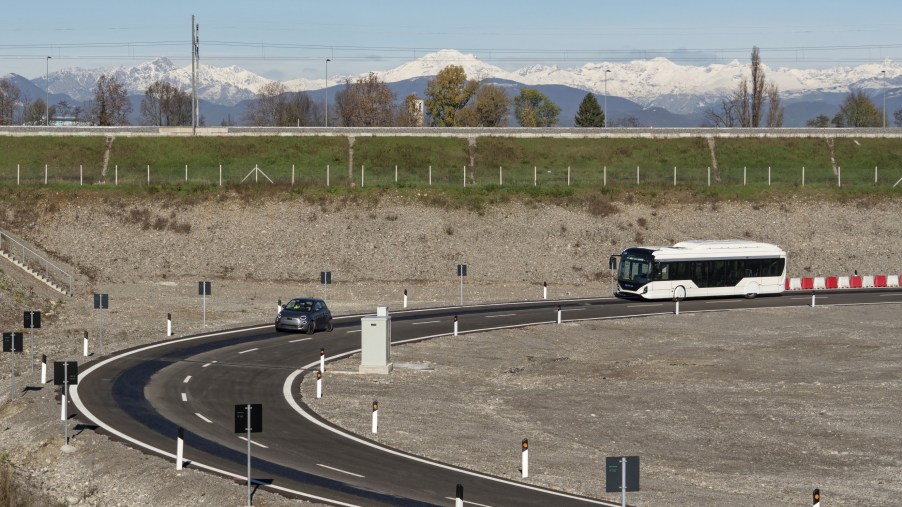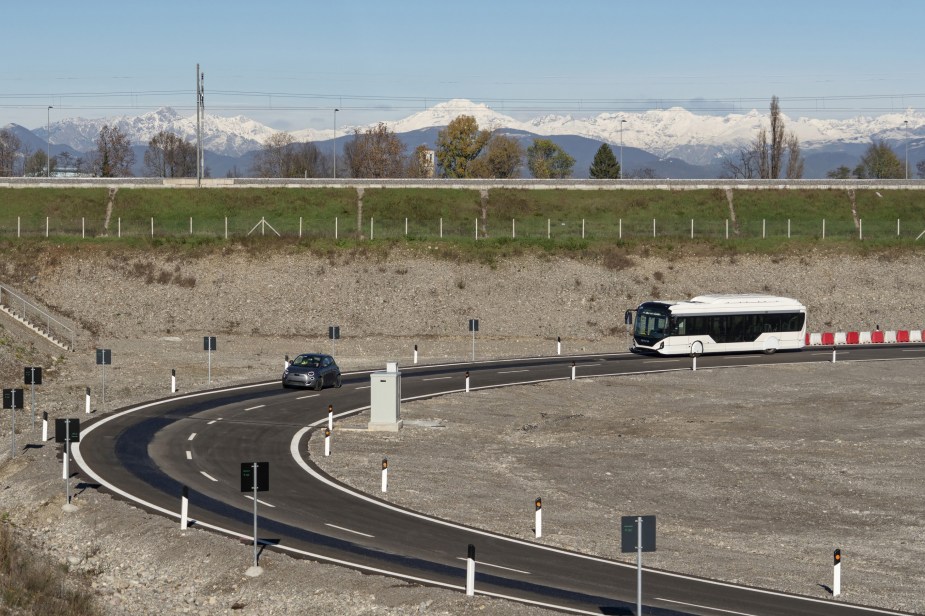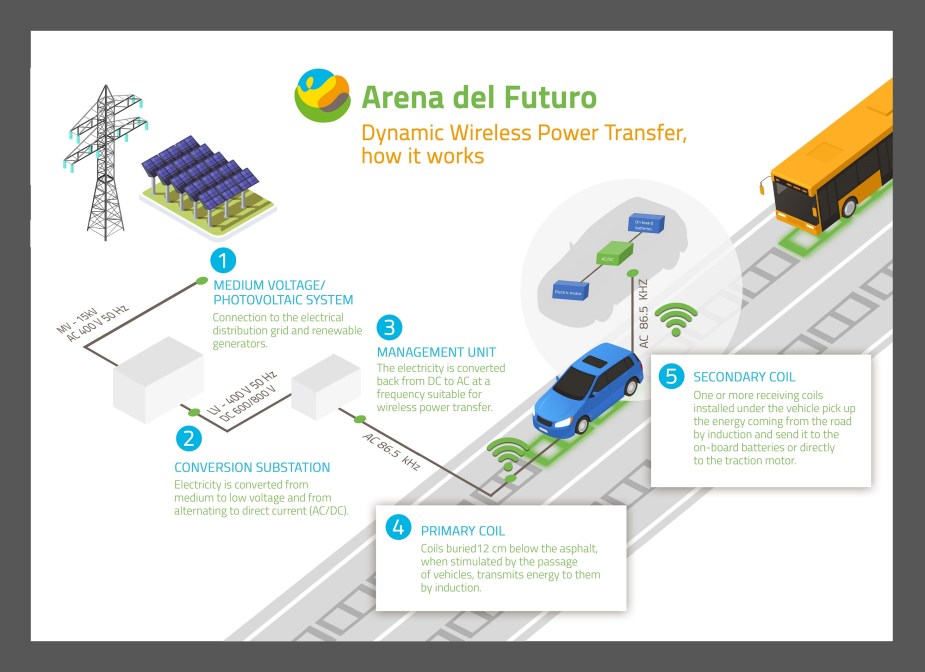
Will Stellantis’ Wireless-Charging Road Cure Electric Car Range Anxiety?
Stellantis electric car wireless charging testing article highlights:
- Stellantis recently ran a Fiat 500 EV around a test track outfitted with a prototype wireless charging system and it let the electric car run without using any battery power
- This system doesn’t recharge the battery but instead powers the electric motors themselves
- Stellantis will test the system with a Maserati electric SUV in the future, but potentially any electric vehicle could use it
Although battery size certainly plays into it, electric car range anxiety is really about EV charging. Ideally, people want EVs to charge as fast as gasoline-powered cars refuel and for functional chargers to be as plentiful as gas stations. But while there’s a lot of work going to the latter, improving the former isn’t nearly as straightforward. However, Stellantis may have just demonstrated something that addresses both issues: on-the-move wireless charging for electric cars.
A prototype Stellantis wireless charging track gave an electric Fiat 500 a seemingly infinite range

Like virtually every automaker, Stellantis is planning to go all-electric within the next decade or so. That means every brand under its umbrella, including Fiat, is beefing up its EV game. And Fiat’s opening salvo is a new all-electric 500 range, Abarth models included.
Yet while the new 500 EV’s 198-mile range is more than sufficient for European commuting, recharging it still takes time. That is if you’re plugging it in. But at its Chiari, Italy “Arena del Futuro” test circuit, Stellantis just showed what’s possible when you cut that cord. And I mean literally.
See, this circuit has built-in wireless charging for electric cars: no power cords here. Furthermore, if the system was powerful enough, you could theoretically replenish your EV’s juice on the move. And it seems that Stellantis took that as a challenge.
In a recent test, Fiat ran its newest electric car on this wireless-charging-equipped circuit at “typical” highway speeds. Stellantis didn’t release the EV’s actual speed, though Italian highway speed limits run in the 55-80 mph range. Normally, electric cars use up a lot of range traveling at those speeds even if they’re not towing anything. However, thanks to the wireless charging tech, the 500 didn’t lose any range; zip, nada, zilch.
Now, this was just the first major test. Stellantis plans to run additional testing with a Maserati Grecale Folgore soon. And just because the 500 EV didn’t use any battery power on the ‘road’ doesn’t mean the Maserati SUV won’t, too. But even so, in terms of reducing electric car range anxiety, this is seriously impressive.
The Arena del Futuro circuit uses a different kind of wireless charging to replenish electric cars

Those with long memories might be scoffing slightly now because Stellantis isn’t the first automaker to dream up wireless charging for electric cars. Nissan and BMW have been kicking the idea around for a while, for example. Also, the upcoming Genesis GV60 will reportedly have wireless charging capabilities, though not necessarily in the U.S. Furthermore, Volvo is currently running wireless charging trials with XC40 Recharges. However, Stellantis’ test circuit goes about it in a novel way.
Usually, wireless charging, aka inductive charging, works the same way in electric cars as it does in other electronic devices. Electricity passes through a metal coil in the charging pad, which creates a magnetic field. This field creates an electric current in another coil mounted within the nearby car/phone/electric toothbrush, thus recharging the battery.
On a basic level, the Arena del Futuro track relies on this principle, hence why Fiat had to mount “a special ‘receiver’” on the 500 EV for the test. But where Stellantis’ system, dubbed ‘Dynamic Wireless Power Transfer (DWPT),’ differs in where the electricity flows. Rather than recharging the battery, DWPT’s charging coils directly power the electric car’s motor(s). Basically, instead of draining its battery, the EV literally runs on the road.
Where DWPT also differs from most wireless charging systems is its speed. Stellantis claims the system is comparable to today’s DC fast chargers, though it hasn’t released actual numbers. So, it could be sending anywhere from 50-350 kW, The Drive says. But there’s a wrinkle.
Know how electric cars connected to DC chargers have fast 0-80% charging speeds but adding the 80-100% range takes a lot longer? It’s because of battery chemistry and design. However, since DWPT powers the motor, not the battery, there’s no need to throttle the electricity. So, it would still work even if your EV had a small and/or degraded battery. In other words, affordable electric cars with shorter ranges would no longer be on the back foot.
Will Stellantis’ EV charging technology make it to American roads?
As of this writing, DWPT is still in the proof-of-concept stage. And considering Maserati’s electric SUV is still a few years away, we likely won’t see this tech in the U.S. anytime soon. However, that doesn’t mean it won’t or can’t come here.
Firstly, there are already plans to build a prototype wireless charging road for electric cars in Detroit. Secondly, although DWPT can juice a 500 EV up to highway speeds, it’s safe for passengers and pedestrians. And while efficient power transfer requires precisely aligning the receiver and the coils, the coils themselves only take up a thin strip of the road.
In addition, because DWPT doesn’t have to convert DC power to AC power, it doesn’t need as many expensive components, The Drive explains. It also means the system can use thin lightweight aluminum wiring, which is also cheaper and easier to recycle than the usual copper. Plus, you can power the system directly off solar panels and/or wind turbines. And any EV with a compatible receiver could use it.
It’s still too soon to tell if this kind of wireless charging will benefit electric cars in the real world. And you’d need to put it on basically every major road for that to happen. But if it works for larger EVs, Stellantis could have a solid salve for range anxiety on its hands.
Follow more updates from MotorBiscuit on our Facebook page.


